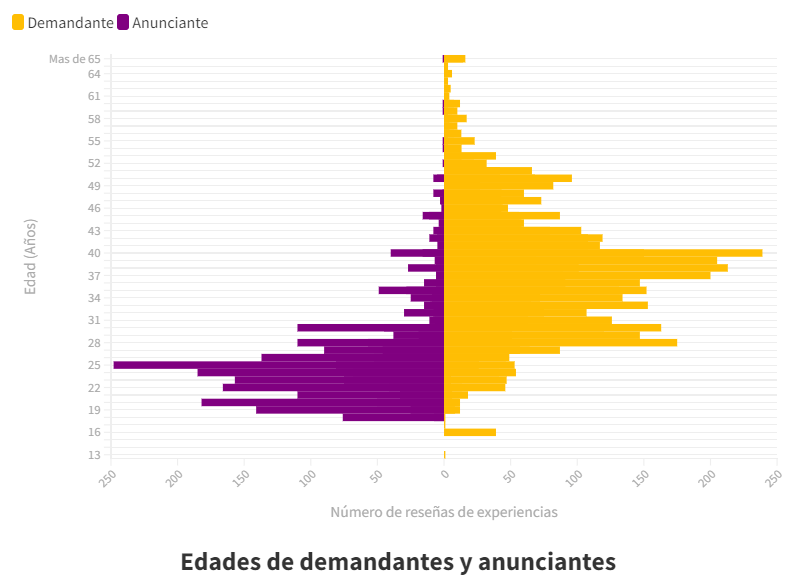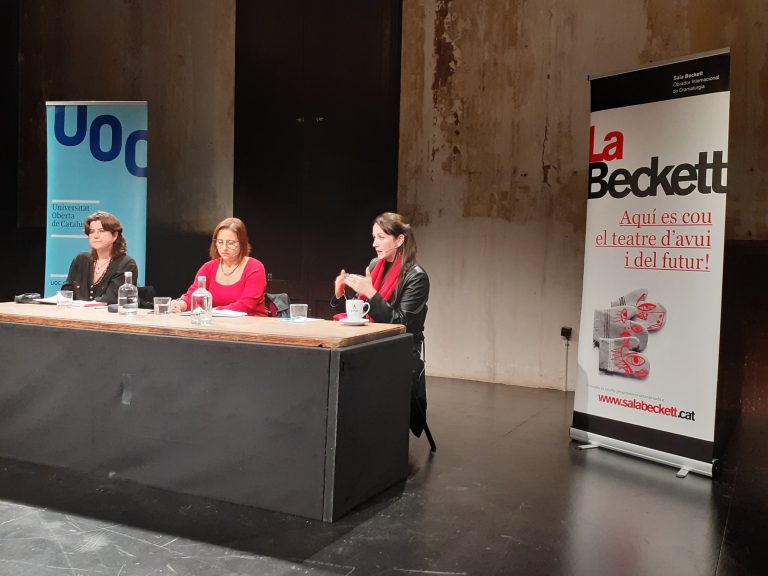Prostitution in the digital age: the case of Spain
8 February, 2023
By Rubén Rodríguez Casañ, researcher in the IN3’s GlobaLS research group.
In the last decade, prostitution has undergone a deep transformation resulting from the widespread use of smartphones and ubiquitous internet access. This is not just a case of moving some of the aspects of interaction and contact (advertising and communication, telephones, services, payment, etc.) to the online world but rather a reorganization of the entire practice, with different times and places and with encounters taking place in a different way.
Despite this transformation, prostitution must be viewed as an institution, i.e. as a system with regulated behavioural guidelines that remain unchanged over time (Ariño, 2022). Prostitution cannot exist without third parties being involved in it, organizing it and profiting from it. We are not dealing with a less organized form of prostitution, as if all intermediaries (rings, pimps, families, madams, etc.) had disappeared and its workers had become independent freelance professionals. Rather, it is a conflict between various forms of prostitution with the addition of new intermediaries (platforms and agencies).
Although these third parties seem to have disappeared from contact websites, making prostitution appear to be simply another experience between two people acting on equal terms and of their own free will (with a rating system), this is not actually the truth. A study of close to 450,000 prostitution advertisements and 21,000 reviews has shown that inequalities of gender, age, class and ethnicity clearly affect the online version too. And there are social facts that we should all bear in mind for the political debate.
Gender inequality
In the world of prostitution services, the vast majority of customers are men, and the vast majority of providers are women. The magnitude of this “social fact” clearly shows and reveals the gender inequalities in our society (Ariño, 2022). The study of the surveys carried out, added to an analysis of online reviews, shows that 99% of people seeking prostitution services are men, whereas most parties advertising prostitution services are women (78-94%), transgender (5-17%) or male (2-6%), depending on the contact website concerned. In places such as the street or brothels, on the other hand, there is even less diversity, with women accounting for almost all providers of these services.
The customer profile analysis has also gone beyond mere gender differentiation. High pornography use, low relevance of romance for sexual encounters, a sexist view of women in society, low educational levels or believing in God (but without practising religion) are some of the most striking features of men who seek prostitution services compared to the rest of the male population, which make it possible to define a sociocultural profile.
Age inequality
Reviews posted in forums of prostitution seekers can be used to ascertain the age distribution of these services’ customers and advertisers.
A clear mismatch immediately stands out. The age range of advertisers spans only a few years, mainly between 18 and 30 years of age, with a peak at 25. The age distribution of customers, on the other hand, is more dispersed, with a median age of 37 or 38 depending on the forum concerned. This age asymmetry logic becomes most worryingly apparent in the exploitation of minors, a practice that is on the rise.
Class inequality
The vast majority of women prostitutes are also from lower social backgrounds than their customers, in terms of both socio-economic and cultural-educational level, and have been forced into prostitution either directly (human trafficking) or by their own or their families’ circumstances of vulnerability and fragility, which they have felt to be insurmountable. The exceptional nature of some cases does not change the fundamental nature of this fact, which clearly shows and reveals class inequality (Ariño, 2022).
Ethnic inequality
In a globalized economy, native women (domestic migrants to cities from rural areas) are displaced and replaced by immigrants from other countries who, in addition to coming from clearly socially disadvantaged areas and families, also have to bear the stigma of being ethnically and culturally different (Ariño, 2022). This distinctive feature clearly shows and reflects ethnic inequality.
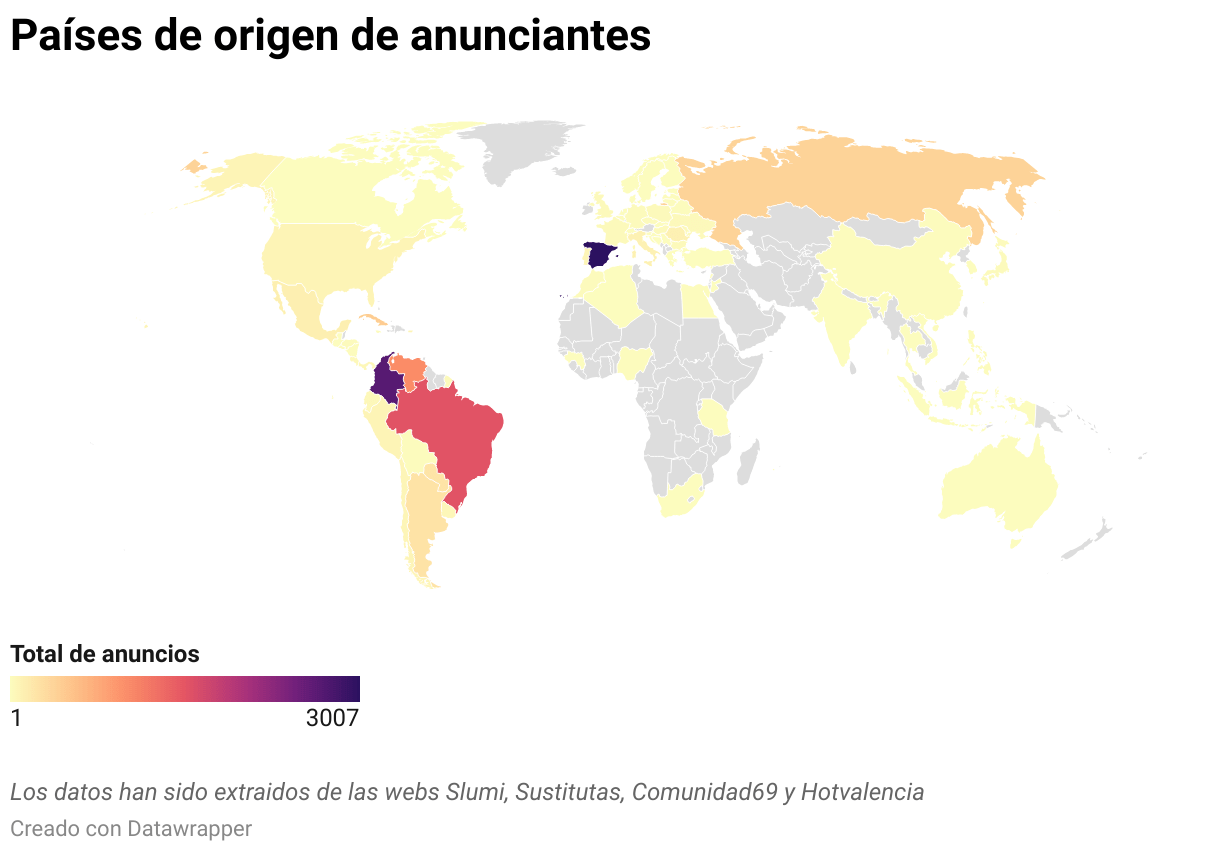
https://www.datawrapper.de/_/csndU/
As to country of origin, Médecins du Monde estimates that 80% of the people they treat in Spain are foreign and 20% are Spanish. The report refutes this process of foreignization and replacement of locals with foreign immigrants. Although Médecins du Monde’s percentages may well be accurate for street and brothel prostitution, the figures may be somewhat lower for online prostitution, because the websites studied suggest that between 68% and 75% of these women are foreign and between 25% and 32% of them are Spanish.
Reorganization of practices, times and places
Platformization has seen digital infrastructures encroach in the various domains of social life. As already mentioned, this is what is happening at bewildering speed in the sex industry and, within it, in the world of prostitution.
The use of digital technologies has caused a large proportion of prostitution to move from streets and brothels to other places such as advertisers’ or customers’ homes, hotels, agencies’ premises, or erotic massage shops, which are more likely to go unnoticed by local residents and escape police control. The difference now is the dissociation between the initial contact (digital marketing) and the actual encounter, which is more based on the customer’s preferences.
People offering prostitution services have had to learn new languages and a new type of sexual presentation marketing in which full details are provided so that prospective customers can refine their search based on physical aspects, special offers, distance, origin, services offered, and even the availability of free parking or a free drink. This ability to refine their search leads to encounters that match the customers’ preferences better and therefore leads to prostitution venues becoming spread out all over the city instead of leaving it. Here is where the rising phenomenon of apartments comes in.
According to the report, Spain has an estimated 4,900 to 5,300 apartments of this nature. The following video shows their distribution in Spain’s major cities:
Map generated from the ads on Slumi and Comunidad69. The ads on these websites give the exact coordinates for the meeting place (apartments).
In the 1990s, cities had dedicated prostitution neighbourhoods. A number of public policies chased this practice out of cities, leading to rows of neon-lit, out-of-town roadside brothels known as “clubes de alterne”. This model is now becoming less prevalent, and opening hours are also changing as a result. The brothel business model is more focused on groups of customers on Friday and Saturday nights. Online advertisements leading to sexual encounters in apartments are used more during the working day and its breaks from Monday to Friday.
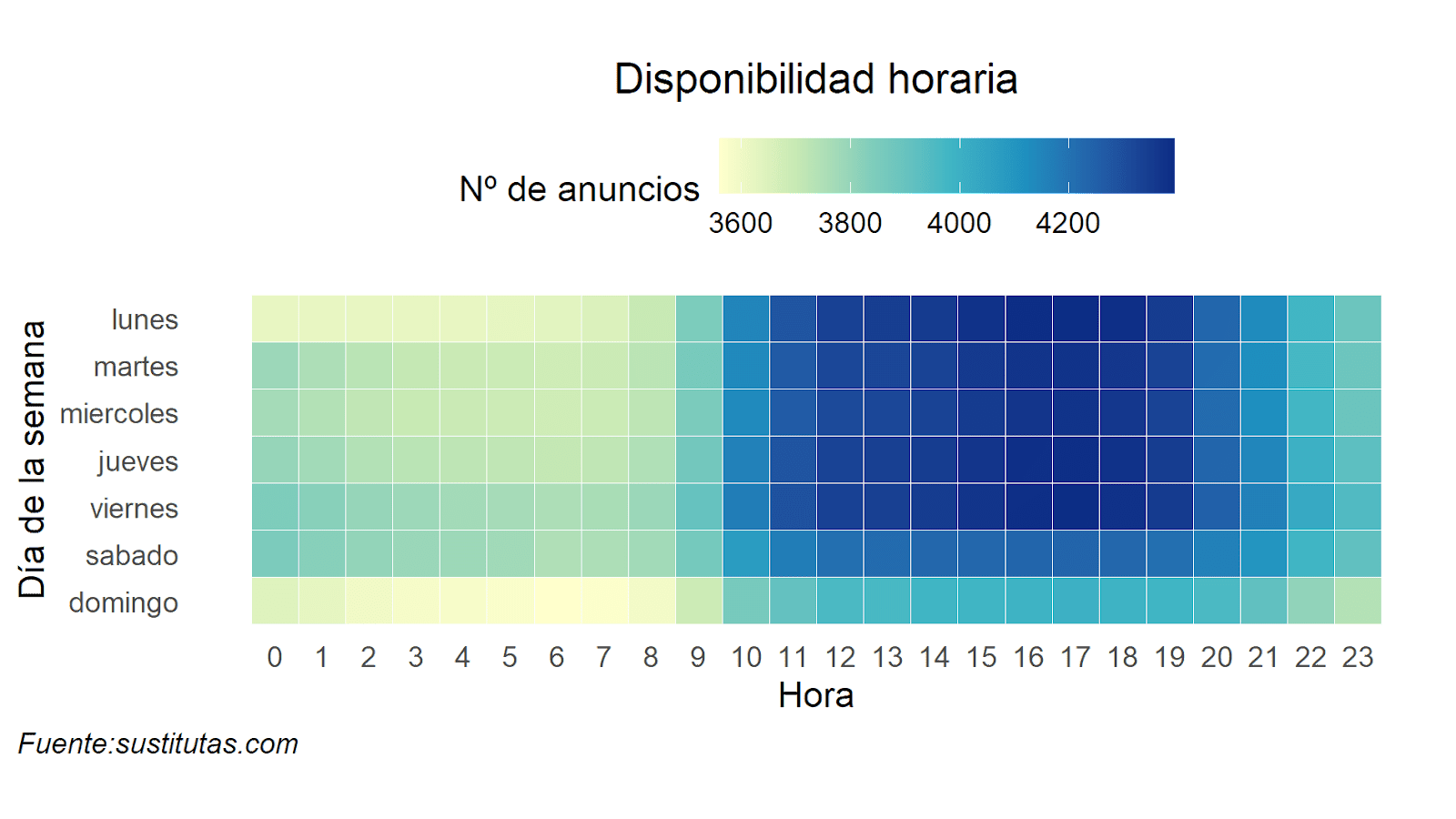
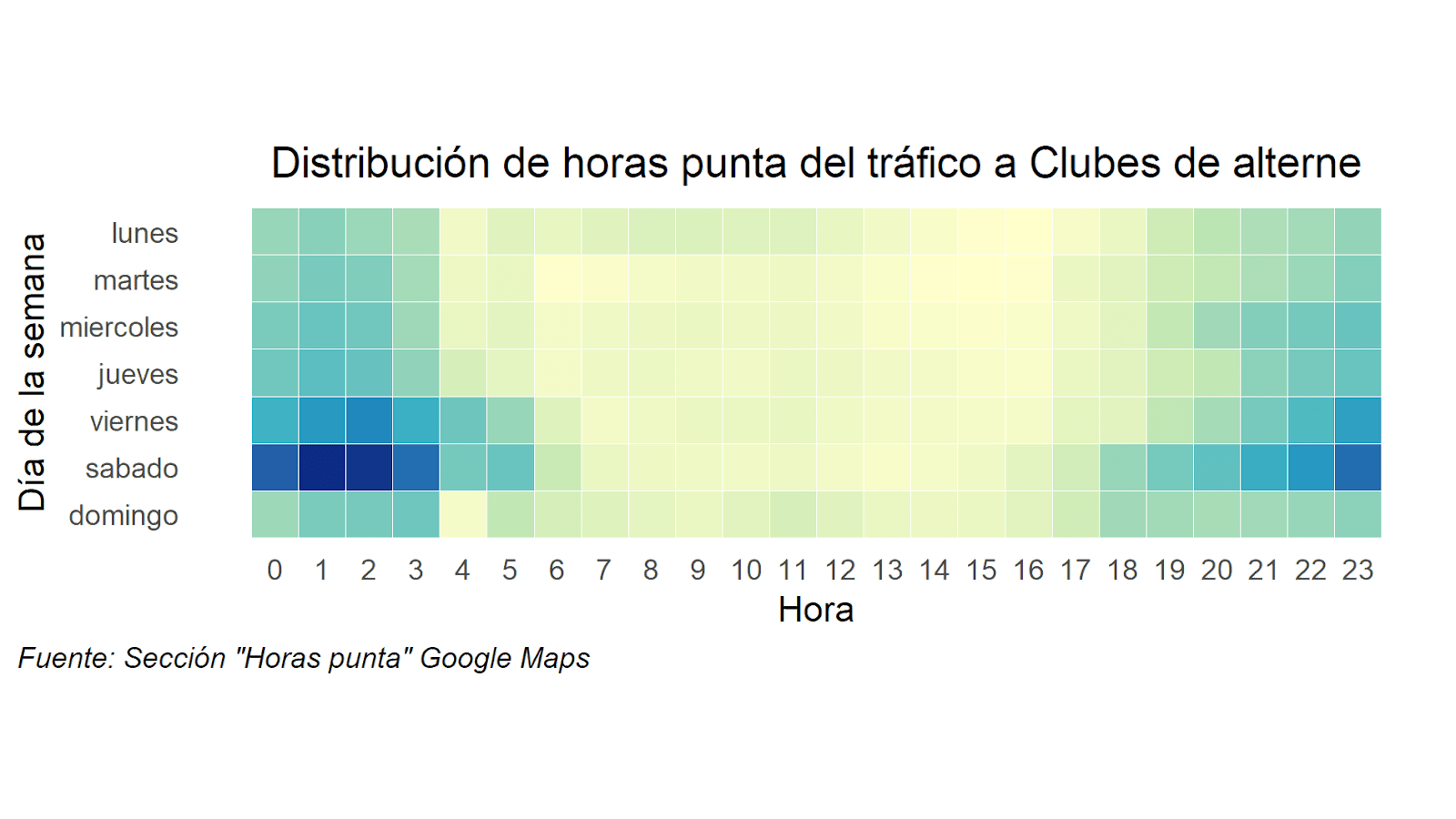
Advertisers’ inter-city travel
All these transformations have made prostitution more mobile and ubiquitous, more dispersed and with greater coverage but, above all, more invisible and normalized (Ariño, 2022). In addition, the strategic informants working in the field have reported the difficulty of keeping in contact with prostitutes in the long term. All this travel throughout Spain prevents NGOs and institutions from creating social work networks.
The advertisements posted on the contact website Slumi were monitored every week in the first four months of 2022. Each advertisement contains information on the location offered by the advertiser. This has made it possible to draw up a map of prostitutes’ mobility in Spain. Over those four short months of observation, 5.1% of people advertising on Slumi did so from different locations. A total of 2,746 trips were recorded, making it possible to chart the main flows of travel. The use of centralizing measures and the optimization of modularity on the network have made it possible to conduct a more in-depth analysis. Certain cities with a large amount of travel between them can be grouped together, and these groups in turn have a particular geographical distribution.
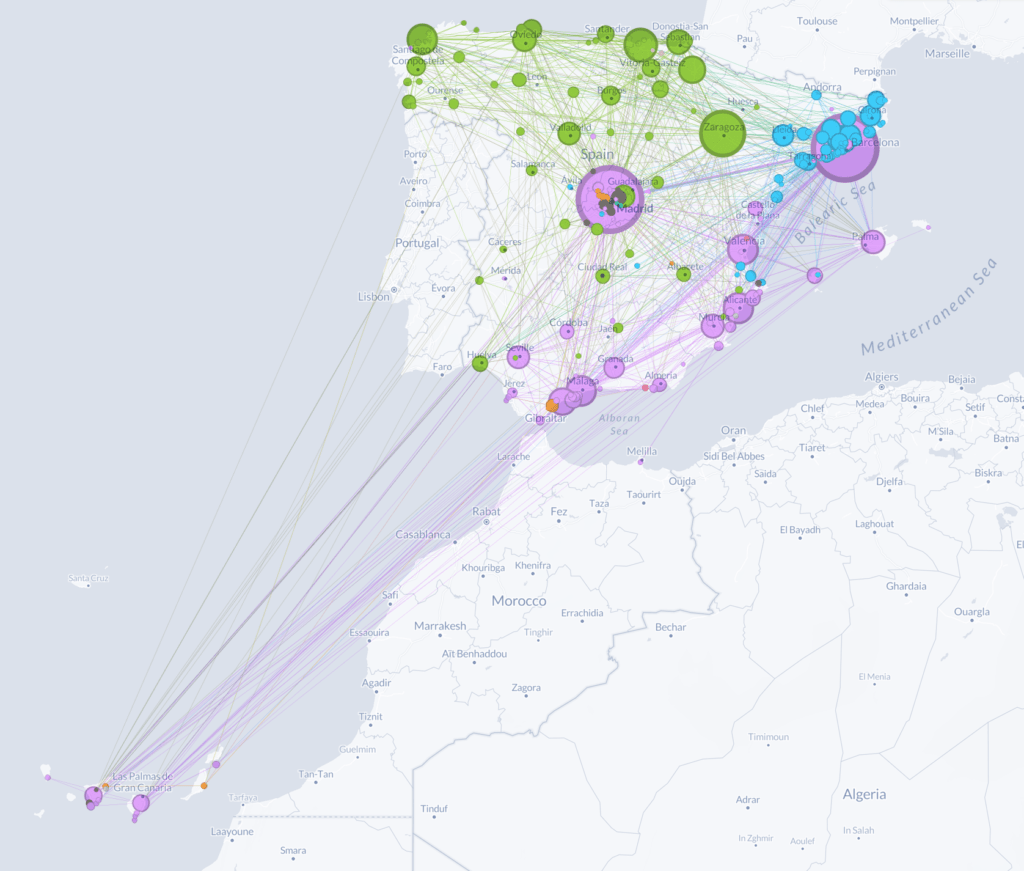
This results in three major geographically distinct clusters. First, there is internal mobility in Catalonia (shown in blue) and some towns in the Valencia region. Barcelona, a large metropolis, is in another group, because a large proportion of its travel is from other highly populated cities such as Madrid, Palma de Mallorca, Alicante and Valencia. Finally, there is a cluster (shown in green) along the Atlantic coast and through Aragon, Castile-La Mancha and Extremadura.
However, the main question is still whether this form of prostitution is nothing more than new forms of subordination and exploitation of women and, therefore, an example of the capitalist patriarchy, or a mere business transaction. The boundaries between buying any item and buying sex are entirely blurred and trivialized on platforms (Ariño, 2022).
What type of social relationship is a prostitution-related interaction? Is it simply a sexual encounter in a world in which sexual emancipation has finally been achieved? Is it not just one of many types of sexual encounter? Is trade liberation the same as emancipation? My answer is unequivocally no. In any case, exploring what happens online is going to be key to the detailed analysis of prostitution in the coming years.
Rubén Rodríguez Casañ is a researcher in the Global Literary Studies Research Lab (GlobaLS) of the Internet Interdisciplinary Institute (IN3) and the UOC’s Faculty of Arts and Humanities, and a student in the UOC’s doctoral programme in Network and Information Technologies.
Notes
(Ariño, 2022) This article is based on extracts from the “La prostitución en la Comunitat Valenciana. Una mirada sociológica” report, whose lead author is Antonio Ariño. A number of paragraphs have been added with information for the whole of Spain. Although the report focuses on Valencia, whenever available, we provide data for the whole of the country. The figures are taken from the last section of the report: V La prostitución en las plataformas.


